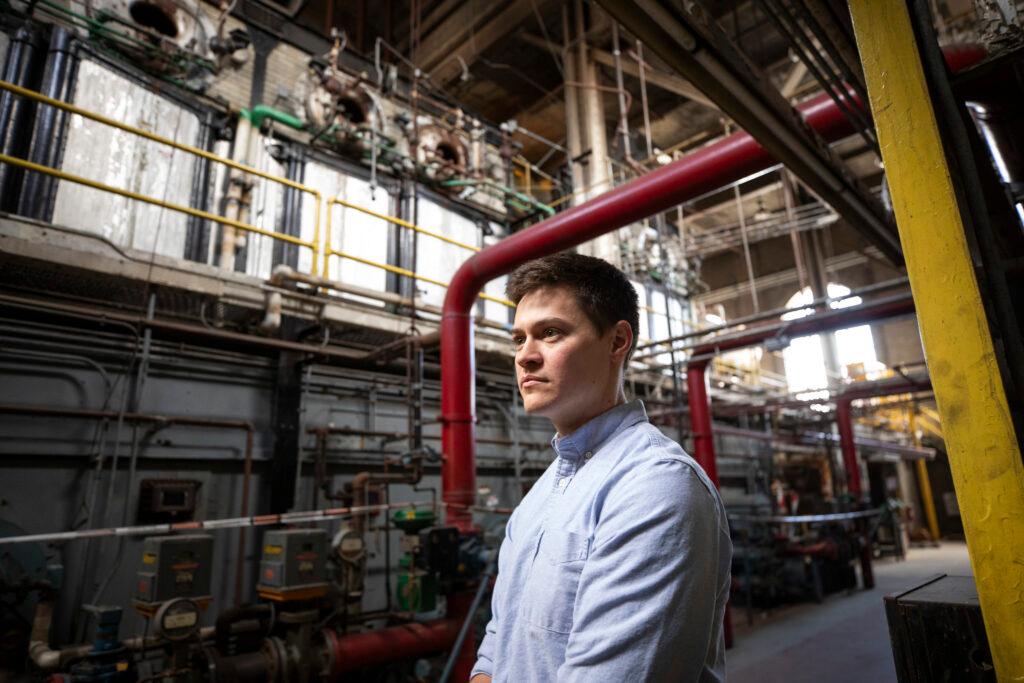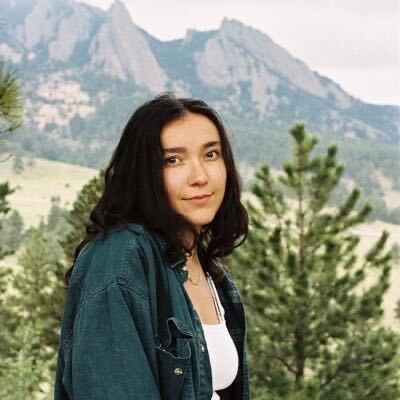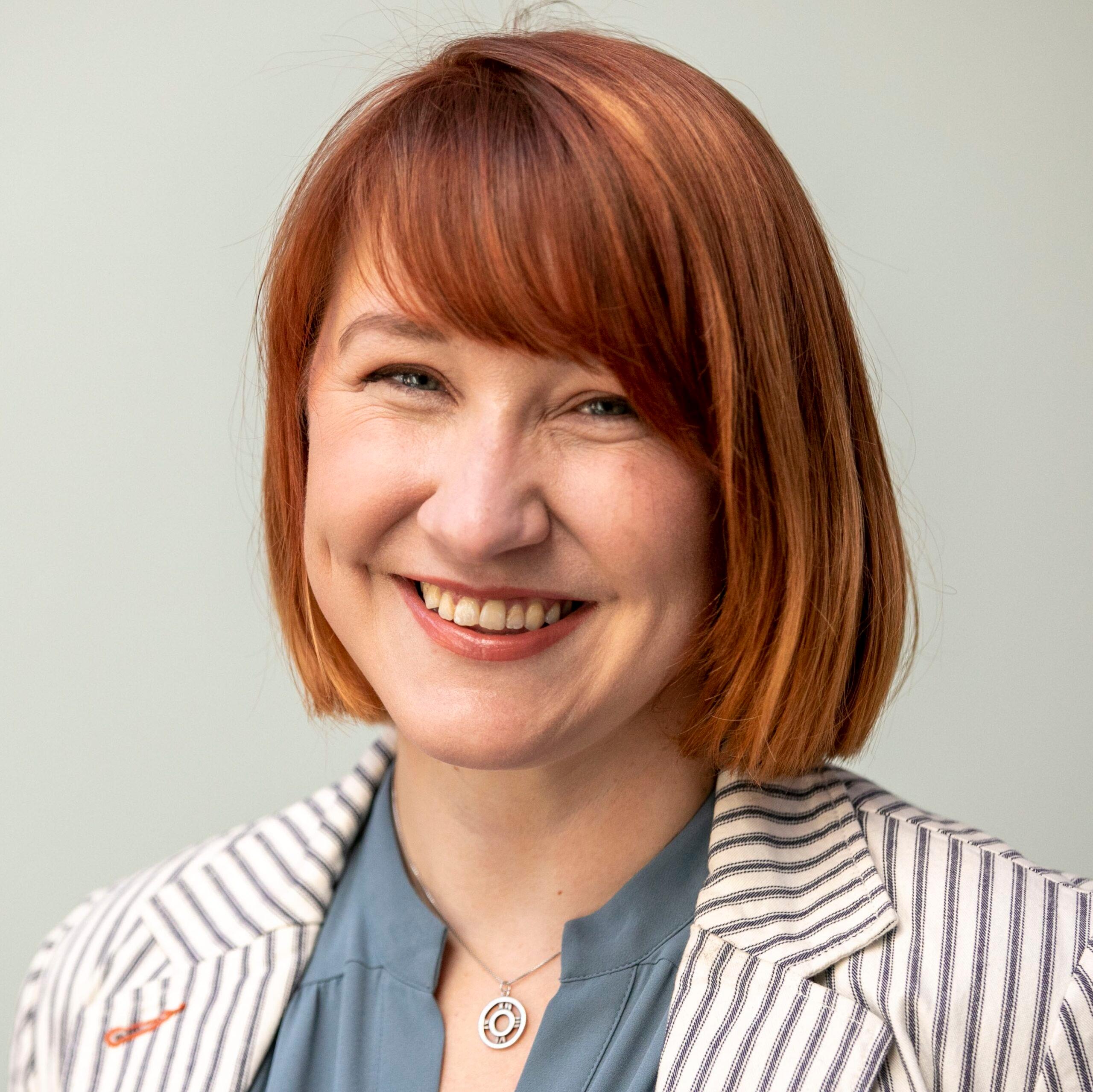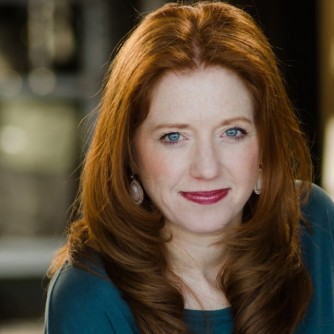
This story is part of the Hotspots series exploring Colorado's geothermal energy industry by CPR's Climate Solutions Team. Explore the series here.
On a hot September day, John Marshall jangled a set of keys inside Colorado Mesa University’s Wubben Hall. Marshall is CMU’s president, and he was here to show off how the campus is largely heated and cooled by water and the Earth’s natural heat, instead of traditional oil and gas.
Unlocking a door tucked between classrooms, Marshall unveiled pumps and humming pipes filled with water, which, outside of this mechanical room, eventually sink hundreds of feet under the pristine quads outside. Those underground pipes form a snaking loop that links together much of the campus.
If it felt unusual for a university president to discuss the inner workings of an HVAC system, Marshall did not seem fazed. That’s because this room is part of a wildly successful project that has saved the university millions of dollars in energy costs, lowered its greenhouse gas emissions and helped keep tuition costs low, according to the university. And now the world is taking notice.
“We really have been at the bleeding edge of this in many ways at scale,” Marshall said.
“We’ve enjoyed tremendous support and cheerleading from Governor Polis. We’ve also enjoyed support from Congresswoman Lauren Boebert,” he added. “And my guess is that there’s not a ton of issues those two agree on, but this is one they do.”
Shifting buildings away from fossil fuels and onto “geothermal energy networks” like CMU’s can help achieve ambitious climate goals, especially as the Trump administration shuns other forms of renewable energy and pulls out of international climate pacts.
For example, in Denver, buildings are responsible for most of the city’s emissions. The city, with tax credits from the state, wants to transition at least 11 buildings in its downtown core, including the public library’s central branch and the art museum, away from a system that depends on natural gas and into one that uses heat from the Earth and other sources.
Holes, pipes, water, pumps
Unlike some forms of geothermal energy, thermal energy networks do not involve drilling thousands of feet underground or extracting scalding water.
Instead, the network relies on the fact that Earth’s shallow crust can naturally absorb and radiate heat. Normally that heat – known as thermal energy – just sits there, untapped. But at CMU, it’s repurposed and transported to a set of buildings, all in a closed loop.
“I think you’d be hard pressed to find another university that's got a more efficient heating and cooling plant on their campus than we do,” Marshall said.
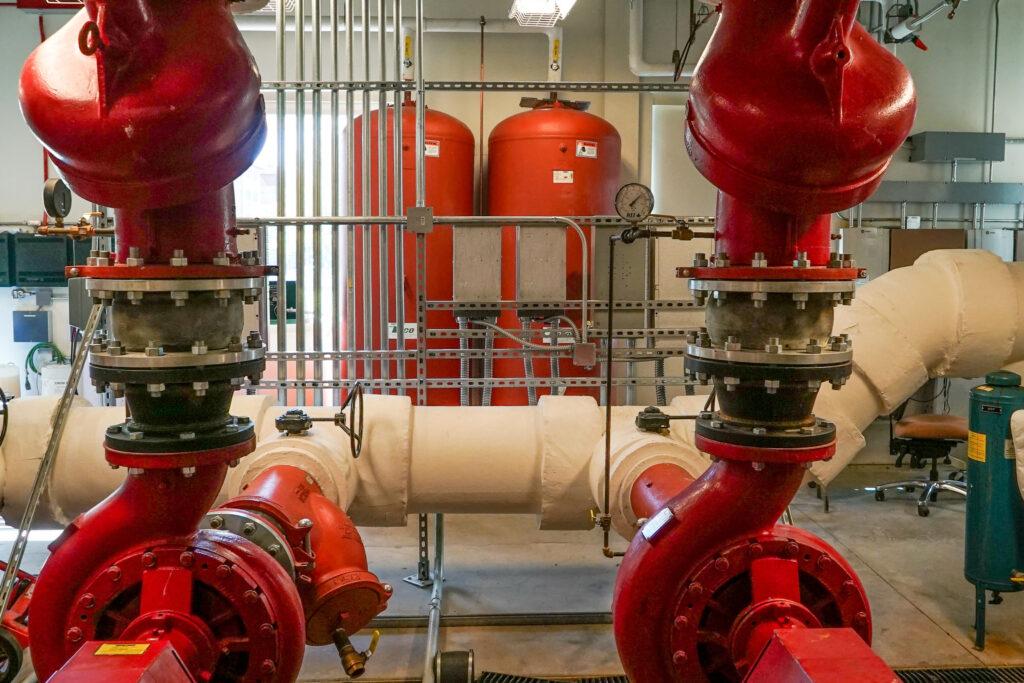
Engineers began designing CMU’s system in 2007. The scrappy public school in the high desert of Grand Junction now uses it to heat and cool over two-thirds of campus, with more buildings on the way.
“The idea of thermal energy networks is that we are transferring heat between buildings and the Earth’s temperature through water,” said Ania Camargo Cortes, an associate director at the Building Decarbonization Coalition, an advocacy group that aims to move buildings away from fossil fuels.
“Instead of having a gas pipe down the middle of the street, you would have a water pipe, and instead of having a gas furnace or boiler in your building, you would have a water source heat pump, or a ground source heat pump.”
The beating heart of many thermal energy networks is a borehole field: a series of holes plunging hundreds of feet underground, like a massive pegboard. Tubes dive down into each hole and come back up, where they eventually connect to each building on the network in a massive loop. Water moves through the tubes at low-pressure, slowly circulating like a lazy river at an amusement park. Boreholes can heat water up or cool it down as it circulates underground.
At CMU, a series of geothermal heat pumps and heat exchangers pull heat out of the circulating water, and use it to warm up the air when a building needs additional heat.
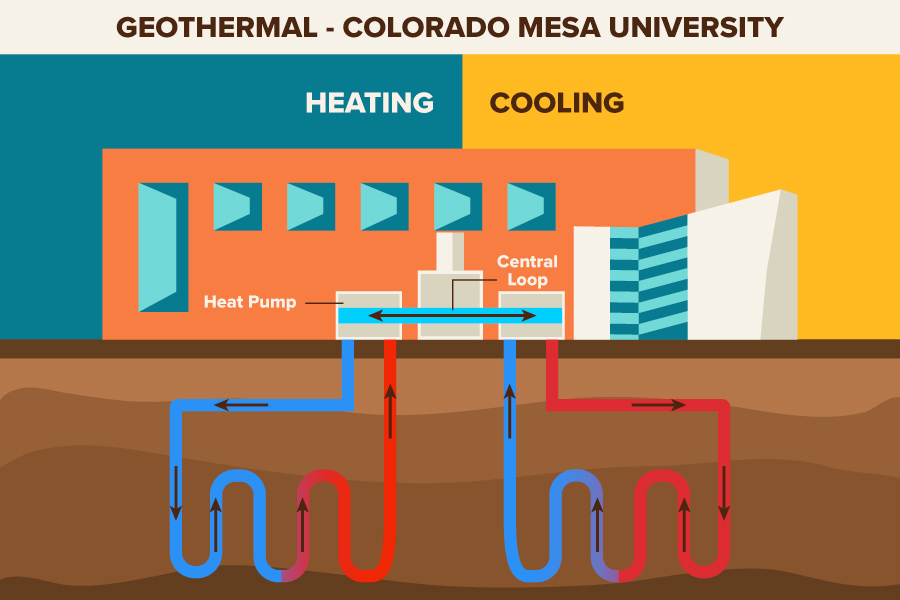
“It’s very low-tech, right?” Marshall, CMU’s president, said, in a bit of an understatement. “It’s just a closed-loop water system.”
Geothermal energy networks are so versatile that places around the country, like Massachusetts, have built similar systems. Xcel Energy, the state’s largest utility, studied CMU’s system for its own pilot projects currently underway in the state. Gov. Jared Polis has cheered on geothermal energy, urging communities to tap into “the heat beneath our feet.” This month the Colorado Energy Office awarded millions in grants and tax credits to kickstart geothermal heating projects.
Building the plane while flying it
According to Marshall, the system’s relative simplicity is largely the work of two people: Kent Marsh, a university vice president in charge of campus operations, and Cary Smith, founder of the consulting firm Sound Geothermal and an architect of CMU’s system.
Smith became enamored with geothermal after working in oil and gas. He said that the technology behind CMU’s network has existed for decades. In 1948, Life Magazine featured a spread from a St. Louis company for a household heat pump system. But at the time, American energy costs were relatively inexpensive.
“Our energy was too cheap, and we didn’t need it,” Smith said.
Smith proposed a thermal network to the university around 2007, when the school was figuring out how to make a building funded by state dollars ultra-energy efficient. At the time, their main challenge was keeping costs low and future-proofing it as the campus grew.
“[Marsh and Smith] kind of drew it up on the dusty hood of a pickup truck, and only half-jokingly, they sort of built that plane while they were flying it,” Marshall, the university president, said.
If CMU’s loop resembled a Wright brothers’ plane in 2007, it’s much more like a Boeing Dreamliner today.
To Marsh and Smith, the system’s beauty is that it allows heat to easily flow between buildings if they need energy. A north-facing, drafty office in the winter may need additional heat to be warmed. Meanwhile, across campus, a lecture hall crammed with students may need to be cooled. Heat pumps can extract heat from the hall and dump it into water. That water flows through the loop across campus, where a pump in another building can extract its heat to warm up the air. That air then flows to the office, heating it up.
“The buildings start moving energy from one building to another, instead of throwing it away,” Smith said.
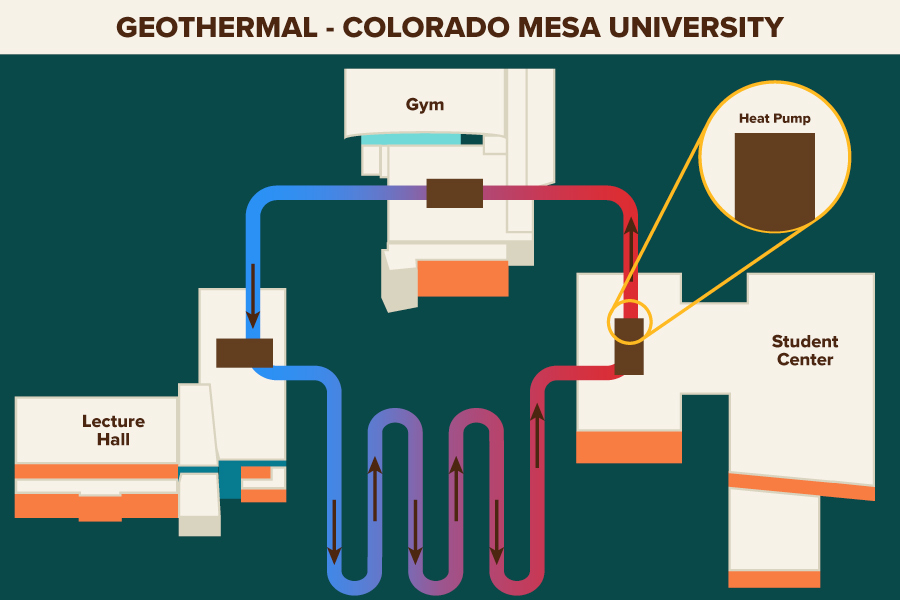
Talking about the network as a whole, he added, “What we’re finding out is the bigger it gets, the more stable it is...If you have the right combination of buildings, you may not have to add a heat source.”
The net result of repurposing heat is that the school has saved around $12 million in energy costs since 2008, compared to a more conventional system. It used those savings to limit tuition hikes even as the school grew, according to Marsh.
And since the Earth’s heat is constant, unlike fluctuations in electricity or gas costs, the university sees its system as a valuable hedge against shifting energy prices.
“We have miles and miles of this running,” Marshall said. “And it really all started around the concept of, how do we hedge against future energy cost increases?”
How it could be replicated in an aging downtown core
Denver’s downtown core features the flagship branch of the public library, the art museum and a convention center, all separate municipal buildings within a few short blocks. Underground, those buildings are linked together by a maze of steam and chilled water pipes, which provide heating and cooling to dozens of buildings.
It’s the country’s oldest continuously operating commercial steam system, which is run by Xcel Energy. The system was a marvel in the 1800s. Now, it’s an expensive proposition in need of upgrade for cost and environmental reasons.
The city said customer bills have doubled in the last decade, and may double again in the next. And Xcel Energy generates the steam used to heat buildings by burning natural gas at a plant near Union Station.
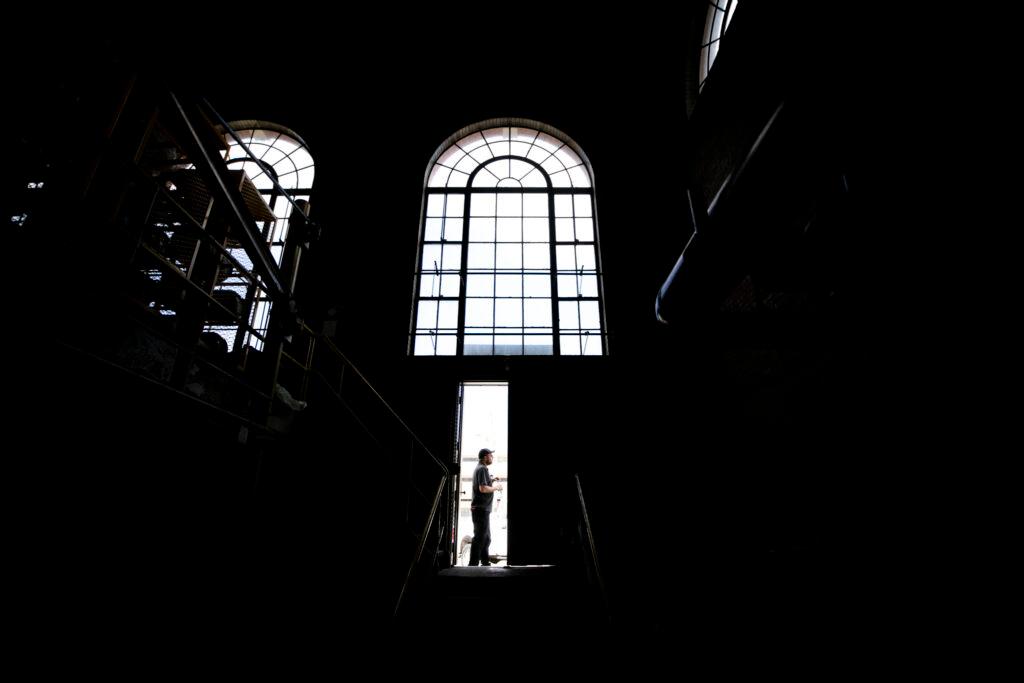
A 2019 rate hike compelled Jonny Rogers, now acting deputy executive director of Denver’s climate office, and other city staff to begin looking for alternatives that would not lock the city in to decades of costly upgrades.
Denver is aiming to reach zero emissions by 2040, and buildings account for around 65% of current total emissions, according to the city. Moving them to “clean heat” not generated by fossil fuels will help the city reach its goals without building more infrastructure like substations or underground gas lines.
A thermal pilot, heated and cooled with a huge poopertunity
In 2024, the city began evaluating a type of thermal energy network, to be piloted over 10 years, to transition 14 city-owned buildings away from steam and chilled water.
Rogers and Drew Halpern, an energy project manager for Denver, say their loop is the most affordable option available to heat and cool certain downtown buildings. Other alternatives, like air-source heat pumps, use much more electricity and would require costly upgrades to ancient electrical systems. They may also require expensive upgrades to Xcel Energy’s electrical grid to accommodate a surge in demand.
A thermal loop, on the other hand, uses much less power with fewer of the expansive electrical upgrades.
“The trick is, how do we convert all of our heating and cooling to an electric version of itself already?” Halpern said. “The only way to do that is with a very energy-dense thermal network.”
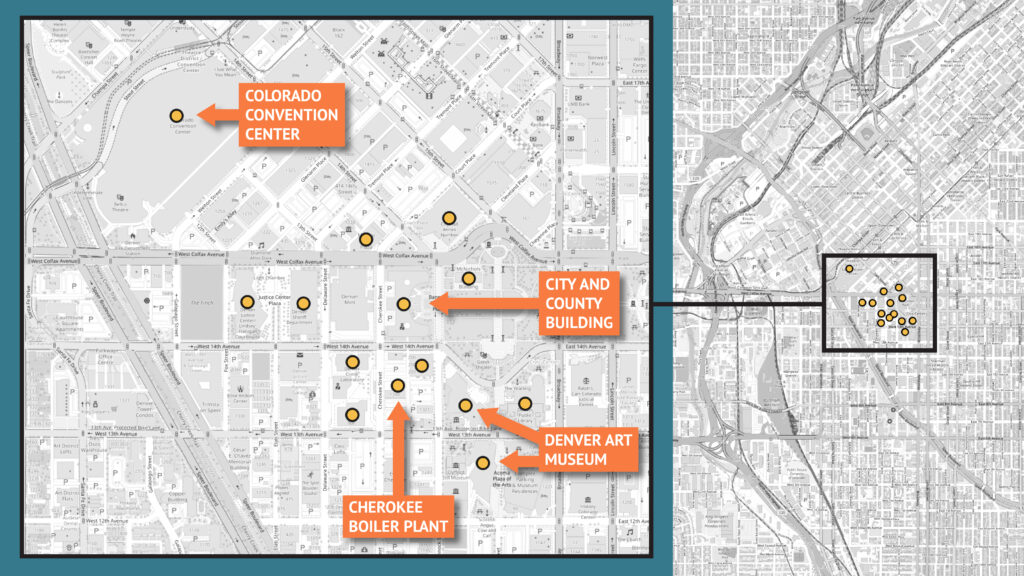
Downtown Denver is a dense metropolis, though, not a university in the high desert with ample acreage and new construction. Halpern and Rogers say the loop will allow the city to create a more efficient system without tearing up downtown. The pilot study imagines drilling borehole fields over existing parking lots, which can then be repaved or turned into something else entirely.
“Once [the boreholes] are underground, it’s ‘set it and forget it’,” Rogers said.
The city also has its sights set on another major source of wasted heat: poop, specifically wastewater from Metro Water Recovery, Denver’s sewage utility.
MWR is required to cool its treated sewage before dumping it into the South Platte River. The city’s pilot imagines using heat-exchangers to siphon off excess heat from sewage before it’s dumped into the river. Rogers estimates there’s enough heat in the wastewater for potentially all the steam customers downtown, with room to spare.
“Heat from the sewer is really the backbone of the opportunity,” Rogers said.
This month, Colorado’s Energy Office awarded the city nearly $5 million in tax credits to continue studying the loop for 11 downtown municipal buildings. MWR also received millions in state grants and tax credits; the utility did not return a request for comment.
The city thinks the pilot is a viable solution, but thorny questions remain, like whether selling thermal heat is a sustainable business model for Xcel Energy.
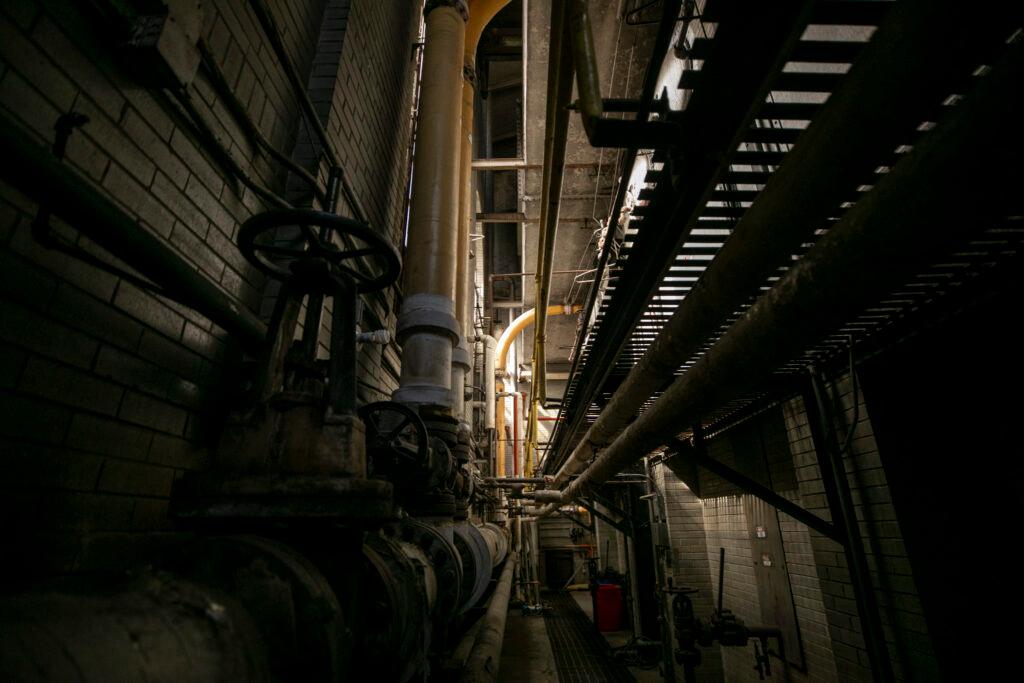
In 2023, Colorado state lawmakers passed HB23-1252, among the first laws in the country to mandate large utility companies like Xcel Energy to pilot thermal networks. Advocates hope laws like these provide an off-ramp for utilities to transition from selling natural gas to selling thermal energy. This year, at least six states have filed legislation allowing utilities to pilot or fund geothermal energy networks, according to Camargo Cortes of the Building Decarbonization Coalition.
“The number one barrier for utilities has been up to now, that they’re not legally allowed to sell anything but gas in most states,” Camargo Cortes said.
Rogers is hopeful Denver’s project will move forward, but stressed that it’s still at square-zero until the city gets every necessary permit. He said that the city arrived at this idea after looking for a goldilocks solution to keep costs low, provide reliable energy and help it meet its climate goals. Like CMU, it found its solution right under its feet.
“The steam system powered Denver’s growth for the last 100 years,” Rogers said. “ We need something to continue our growth for the next 100 years in a way that doesn't destroy the planet and everything that we're trying to accomplish to meet our goals.”
